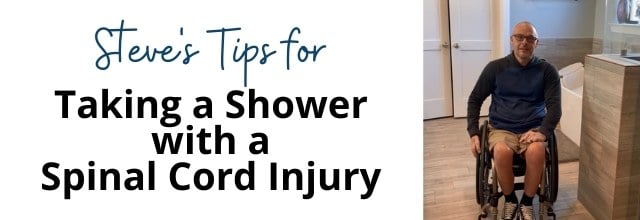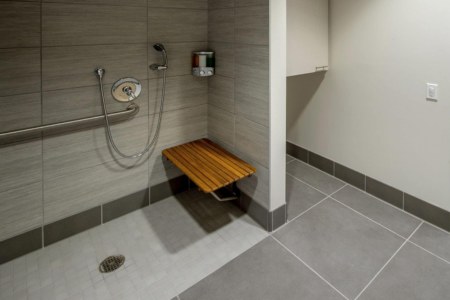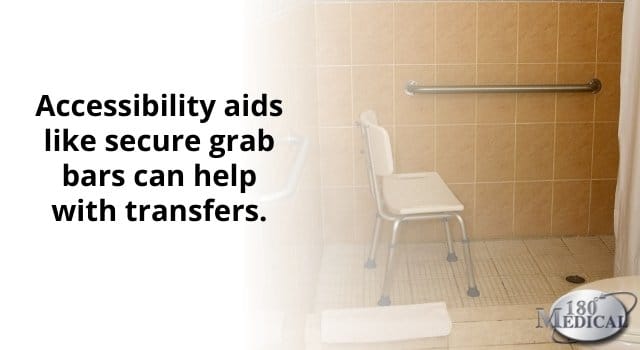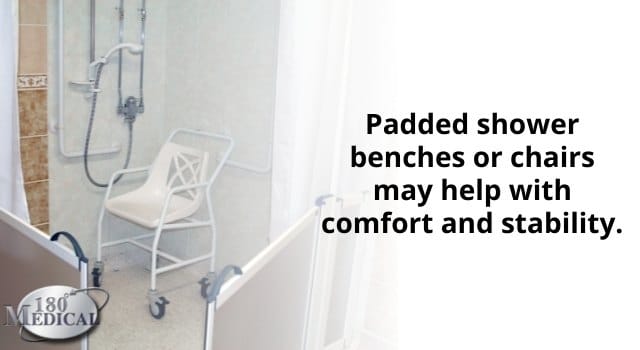
After a spinal cord injury (SCI), accomplishing tasks like taking a shower, driving a car again, or handling chores is a big part of regaining your sense of independence. My name is Steve, and I’m a Patient Advocate at 180 Medical. I’ve been living with a C6 complete spinal cord injury due to a car accident since 1988. So, I understand firsthand what it can be like when you’re newly navigating the world in a wheelchair.
Even if you have a spinal cord injury, there are still options for completing self-care tasks on your own, such as taking a shower independently.
The Importance of Independence with a Disability
As a Patient Advocate, I often visit with newly injured patients in rehabilitation hospitals. One of the things I love most about my role is helping people see how much they can still accomplish.
When people are new to a spinal cord injury, they’re adjusting to a lot of big changes. You’ll naturally have some questions about how to maintain your health with a spinal cord injury. Plus, it’s normal to have some concerns about independence when you’re getting used to a wheelchair.
Getting back your independence can greatly improve your overall quality of life after a spinal cord injury. Being able to accomplish things on your own, no matter how small they may seem, can give you back confidence and a sense of purpose.
Also, achieving new things, like showering on your own, can help move forward after a spinal cord injury.
Is Taking a Shower with a Spinal Cord Injury Possible?
So, can people with spinal cord injuries bathe or shower independently? Absolutely, it’s very possible.
Of course, remember that it will likely involve a little trial and error. But don’t let a momentary failure detour you from continuing to try.
Before trying it out alone, you might want to clear it with your doctor, occupational therapist, or rehab therapist. They’ll be the best go-to for advice. They may also connect you to some resources for accessible home equipment.
Additionally, for safety purposes, I would encourage you to initially have a friend, family member, or caregiver nearby, just in case.
If you’re ready, I’ve got a few more tips for taking on this new task independently.
My Top Tips for Taking a Shower with a Spinal Cord Injury
Now, here are a few tips that should help you on your way to taking a shower with a spinal cord injury on your own.
Tip 1. Make your bathroom wheelchair accessible.
Now, if you’re ready to try showering independently, you’ll want a wheelchair-accessible bathroom at home.
I prefer a roll-in shower, but many individuals with spinal cord injuries can also use a regular bathtub.

Here are a few additional mods for accessibility:
- Install a wider shower door for a roll-in shower to allow wheelchair access or go “barrier-free.”
- Raise the shower floor a bit or create a ramp entry for easier access
- Use securely installed grab bars to help with transferring and positioning
- Get a handheld shower attachment
- Try using a suction cup handle if you need help closing the shower door from the inside
Need help with home modifications?
Some organizations offer assistance, such as grants for people with spinal cord injuries, which could help pay for the costs of modifying a home for wheelchair accessibility.
Also, you might check with your insurance. Some private insurance plans and even some state Medicaid plans may pay for modifications to your home.
You can install accessible shower aids like grab bars and handles for fairly cheap.

Tip 2. Use a padded shower bench or chair.
Whether you have a roll-in shower or a regular bathtub, you can still use a shower bench. Just place your padded shower bench in an area that allows for safe transfers. Also, make sure your bench is within easy reach to access everything, including the faucets and handle, to turn the water on and off.
You can get a relatively inexpensive padded shower bench at online stores. These can come as a fully padded bench with a backrest or a toilet-shaped cut-out bench option. I know some people who use padded shower wheelchairs, which are great, but they can be a more expensive option.
With having a C6 complete SCI, I prefer the cut-out shower benches. It helps me with stability. When I use a full padded bench, I feel like I will slide right off. Not a great feeling!
Fellow quadriplegics, you may want to set the transfer level (shower bench height) even to your wheelchair seat height, making easier transfers.

Tip 3. If you’re a frequent traveler, try a travel shower bench.
You should be able to get a wheelchair-accessible room and bathroom at any hotel. While some hotels even include a shower bench in their accessible bathroom setups, you’ll probably want to invest in a travel bench of your own if you travel frequently.
Do a little searching online, and you’ll find some pretty great options. I personally like the Nuprodx Mobility MC3000TX portable shower transfer bench.
However, some of these travel options may be more expensive than the basic padded shower benches mentioned above.
Tip 4. Use a handheld shower nozzle attachment.
Some people prefer to take a shower the standard way with the shower head over them. I like to use a handheld shower nozzle attachment to spray to clean all around my body.
A handheld showerhead is not only super easy to install but also offers easier control over cleaning those hard-to-reach places.
If you have limited hand dexterity, it won’t matter if you happen to drop your showerhead. Thanks to its attachment hose, it won’t ever stray too far from your reach.
Plus, some newer low-flow showerhead attachments help reduce water waste, which might help keep your water bills low.

Tip 5. Keep your phone nearby.
When you’re bathing or showering alone with a spinal cord injury, it’s a good idea to keep a phone nearby. I typically keep mine somewhere on my wheelchair within reach but outside the range of water spray.
If a rare spill or fall happens, you can call for help. Having a voice-activated call option through a virtual assistant like Apple’s Siri can also be helpful.
Tip 6. Check your water temperature constantly.
If you have limited to no sensation, you must constantly check the water temperature.
I have friends who have gotten serious burns from showering and did not realize it until it was too late. Avoid this by checking the temperature of your water.
Many household water heaters have a preset temperature, which is often way hotter than you really need. Some people like to have the set temperature on their water heaters turned down closer to 120 degrees or even lower. While still hot, it might help prevent severe burns from occurring in the shower.

Tip 7. Watch out for potential slips or falls.
Remember: “slippery when wet!”
When you shower, your wheelchair will be more prone to moving and slipping in wet areas. Especially early on, ensure that a friend or family member is home and within yelling distance in case you need help.
Proper shower equipment may also help prevent unexpected falls or slips. For example, many shower benches can be installed directly into the wall, while others have rubbery, non-slip feet that grip the shower floor and help prevent the bench from moving.
Tip 8. Practice makes perfect.
Lastly, remember that you’re probably not going to be an expert at taking a shower with a spinal cord injury right off the bat. Don’t let yourself get discouraged too easily.
It will become easier the more you do it. Practice makes perfect. So, keep practicing and working toward safe and independent outcomes.
Where to Get Urological Supplies
Of course, one crucial part of maintaining your independence is handling all of your bathroom routines, including learning how to self-catheterize with a spinal cord injury.
And yes, even if you have limited hand dexterity like me, self-cathing could still be possible.
180 Medical is one of the leading catheter companies in America today, with a large inventory of intermittent catheter options of all types and brands.
We’ve got some really special people on staff who know the products we carry inside and out. If you need help finding the right catheter or figuring out what your insurance will cover, contact 180 Medical.
As always, feel free to reach out to 180 Medical to get in contact with me. I’m happy to help!
Disclaimer: The information provided here is for informational purposes only. This is not medical advice nor is it a paid advertisement or recommendation. External product references or links do not constitute a formal endorsement.
